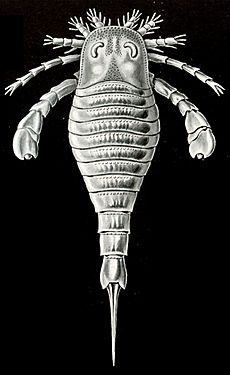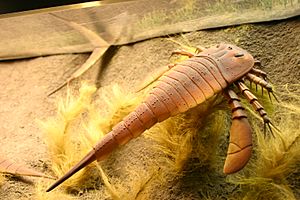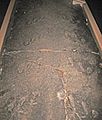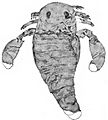Eurypterid facts for kids
Quick facts for kids EurypteridaTemporal range: Ordovician–Permian
|
|
|---|---|
 |
|
| Eurypterid from Ernst Haeckel's Kunstformen der Natur (1904) |
|
| Scientific classification | |
| Kingdom: | |
| Phylum: | |
| Subphylum: | |
| Class: | |
| Order: |
† Eurypterida
|
Eurypterids were a fascinating group of extinct marine arthropods that lived millions of years ago. They were the largest arthropods ever known! These incredible creatures were informally known as "sea scorpions" (though they weren't true scorpions and many didn't live in the sea). They belonged to the order Eurypterida, and their name comes from Ancient Greek words meaning "wide wing," referring to their broad swimming paddles.
Some eurypterids, like Jaekelopterus, could grow up to 2.5 meters (about 8 feet) long. That's longer than a tall person! Most species were smaller, usually less than 20 cm (8 inches). Eurypterids were predators, meaning they hunted other animals for food. They lived in warm, shallow seas and lakes. These amazing creatures thrived from about 460 to 248 million years ago. This time period spans the Ordovician to the Permian periods. Scientists think their eyesight was not very good.
Over time, some eurypterids moved from saltwater to freshwater. This likely happened by the Pennsylvanian period. All eurypterids died out during a huge event called the Permian–Triassic extinction event. This happened about 251 million years ago. Their fossils have been found all over the world.
Contents
Meet the Sea Scorpions!
- Ancient History: The earliest known eurypterids appeared around 467.3 million years ago during the Ordovician period. They were around for a very long time, becoming major players in marine ecosystems during the Silurian period, and finally disappearing about 251.9 million years ago during the Permian–Triassic extinction event, one of Earth's biggest mass extinctions.
- Amazing Diversity: With about 250 known species, eurypterids were the most diverse group of chelicerates (a type of arthropod that includes spiders and horseshoe crabs) during the Paleozoic Era. The genus Eurypterus alone accounts for over 90% of all known eurypterid fossils!
- Habitat Hoppers: While the first eurypterids lived in the ocean, many later forms adapted to living in brackish water (a mix of fresh and salt water) and even completely fresh water. Some studies even suggest they might have had a special breathing system that allowed them to spend short periods on land!
- Giants and Minis: Eurypterids hold the record for the largest known arthropods ever to have lived! The biggest, Jaekelopterus, could reach an astonishing 2.5 meters (8.2 feet) in length – that's longer than a small car! However, not all eurypterids were giants; most species were less than 20 centimeters (8 inches) long, and the smallest, Alkenopterus, was only about 2.03 centimeters (0.80 inches) long.
- Global Travelers: Their fossils have been found on every continent, showing just how widespread they were. Most fossils come from North America and Europe because they primarily lived in the waters around the ancient supercontinent called Euramerica.
Body Structure: Built for Survival
Like all arthropods, eurypterids had segmented bodies and jointed limbs covered in a tough outer shell called a cuticle, made of proteins and chitin. Their bodies were divided into two main sections:
- The Prosoma (Head): This front section was covered by a shield-like carapace. On top of this shield, they had both compound eyes (like an insect's, good for detecting movement) and ocelli (simple, light-sensing organs).
The prosoma had six pairs of limbs.
- Chelicerae (Pair I): These were small pincers located before the mouth, used to grab and manipulate food. However, in one special group called the Pterygotidae, these chelicerae were huge and powerful, with strong teeth, perfect for catching and tearing prey.
- Walking and Feeding Legs (Pairs II-VI): These limbs had "gnathobases" (or "tooth-plates") at their base, which helped them chew food. They were generally cylindrical walking legs, and some even had spines. In many eurypterids, the legs got bigger towards the back of the body.
- Swimming Paddles: In the larger suborder, Eurypterina, the sixth pair of appendages was specially modified into wide, flat swimming paddles, making them excellent swimmers.
- The Opisthosoma (Abdomen): This was the back part of the body, made up of 12 segments and a tail-like structure called a telson.
In most species, the telson was blade-shaped. But in some groups, like the Pterygotioidea, it was flattened and likely used as a rudder for steering while swimming. Interestingly, some eurypterids, like Eusarcana, had a telson that looked very much like a true scorpion's tail and might even have been able to inject venom!
The underside of the opisthosoma was covered by plate-like structures called Blattfüsse (German for "leaf-feet"). These created a special chamber where their respiratory organs, called "gill tracts," were located. These gill tracts were either oval or triangular and had tiny spines, increasing their surface area for breathing.
The first two segments of the opisthosoma were fused into a structure called the genital operculum. In its center was a genital appendage, which came in two distinct forms ("type A" and "type B"), believed to correspond to male and female.
Adaptations
Eurypterids were truly remarkable creatures, adapting to changing environments over millions of years. Their story is a testament to the power of adaptation in the history of life on Earth. Here are some of the incredible adaptations they developed:
- Most eurypterines likely used a rowing motion, similar to crabs or water beetles. However, larger individuals might have been capable of "underwater flying" (or subaqueous flight). This is where the shape and motion of their paddles generated enough lift to move through the water, much like sea turtles or sea lions. This method was slower to accelerate but more energy-efficient for their large bodies.
- Breathing was a crucial adaptation for eurypterids, especially as they moved from marine to freshwater and potentially even land environments. Eurypterids's respiratory organs were located on the underside of their abdomen, within a chamber created by the Blattfüsse. These organs, called "gill tracts," were spongy, with many folds and small spines to increase their surface area.
Some researchers suggest these "gill tracts" might have been adapted for breathing air, perhaps functioning like a lung or a pseudotrachea (similar to lung-like organs found in modern isopods). This would have been essential for any time spent out of water. It's possible that some eurypterids had a dual respiratory system, allowing them to breathe both in water and for short periods on land. However, the exact mechanism for underwater breathing (true gills) remains a bit of a mystery in the fossil record.
- Many eurypterids had stereoscopic vision, meaning they could perceive depth, which is a common trait in predators that need to accurately target their prey.
- The legs of many eurypterids were covered in thin spines, which not only helped them move but also to gather food.
- Some groups developed highly specialized feeding appendages: In the Carcinosomatoidea, eurypterids like Mixopterus and Megalograptus had large, forward-facing appendages with enormously long spines, perfect for grabbing and holding prey. Derived members of the Pterygotioidea had appendages without spines but with specialized, powerful claws, ideal for crushing or tearing.
Evidence of Diet
While direct fossilized gut contents are rare, scientists have found fossilized digestive tracts in species like Carcinosoma, Acutiramus, and Eurypterus. Some fossilized droppings (coprolites) from Ordovician eurypterids contain fragments of trilobites and even smaller eurypterids of the same species, suggesting that cannibalism might have been part of their diet! Other coprolites contained fragments of jawless fish. While the very largest eurypterids were apex predators (at the top of the food chain), even smaller species were likely fierce hunters in their own right.
Life Cycle and Growth
Like all arthropods, eurypterids grew by molting their tough outer cuticle in a process called ecdysis. They went through different developmental stages called instars.
For a long time, scientists debated whether eurypterids were "direct developers" (meaning their hatchlings looked very similar to adults) or "hemianamorphic direct developers" (meaning they added extra body segments or limbs as they grew). Studies on well-preserved fossils from Wyoming, including juvenile and adult specimens of Jaekelopterus and Strobilopterus, have shown that eurypterids were true direct developers, much like modern arachnids. This means they hatched with a full set of appendages and abdominal segments, looking like miniature versions of their parents.
One common change observed as eurypterids grew was that their metastoma (a plate on the underside of the abdomen) became proportionally less wide.
Reproductive Biology: A Fossil Mystery
Understanding how extinct animals reproduced can be tricky, as we only have their fossilized shells to study. However, scientists have pieced together some clues about eurypterid reproduction.
The most important clue comes from their genital appendage, located on the underside of the second abdominal segment. This appendage came in two distinct forms: "type A" and "type B."
- Type A (Female?): Type A appendages were generally longer and sometimes divided into sections. They often had two curved spines called furca. Scientists believe these were likely the female appendages, possibly used to pick up spermatophores (sperm packets) from the environment. Organs called "horn organs," possibly for storing sperm (spermathecae), were also associated with type A appendages.
- Type B (Male?): Type B appendages were typically shorter and often undivided. They likely produced and stored spermatophores in a heart-shaped structure. The furca on these appendages might have been used to test if a surface was suitable for depositing spermatophores.
Beyond the genital appendages, there might have been other differences between male and female eurypterids, such as size, body width, or ornamentation. For example, males (with type B appendages) often appeared proportionally wider than females (with type A appendages) of the same species.
Evolutionary Journey
The history of eurypterids is a story of continuous adaptation and evolution over vast stretches of geological time.
- Early Beginnings (Ordovician): The first definite eurypterids, like Pentecopterus, appeared in the Middle Ordovician, about 467.3 million years ago. Their relatively advanced features suggest that their ancestors might have appeared even earlier, perhaps in the Early Ordovician or Late Cambrian. The Ordovician fossil record is sparse, but it shows the emergence of the first truly successful eurypterid group, the Megalograptidae, which were large, active predators.
- The Silurian Boom (Peak Diversity): Eurypterids truly flourished during the Silurian period, especially in the Late Silurian (423 to 419.2 million years ago). This was their absolute peak in diversity and abundance.
- Eurypterus Dominance: The most successful eurypterid of all time, Eurypterus, appeared during this period. It was a generalist, meaning it could be a predator or a scavenger, and its fossils are incredibly common. However, Eurypterus was geographically limited to the ancient continent of Euramerica.
- Pterygotid Giants: The Late Silurian also saw the rise of the pterygotids, which were large, specialized eurypterids with flattened telsons (for steering) and huge, powerful chelicerae. These were active apex predators and were one of the few eurypterid groups to achieve a worldwide distribution.
- Devonian Decline (Extinction Event Impact): While eurypterids continued to diversify in the Early Devonian (producing giants like Jaekelopterus), they were severely impacted by the Late Devonian extinction event, which mostly affected marine life.
- Eurypterine Struggles: The eurypterine suborder suffered greatly, with over 50% of their diversity lost in just 10 million years. This decline might have been linked to the rise of more advanced fish, like placoderms (armored fish), which became new competitors and predators.
- Stylonurine Resilience: Stylonurines, however, adapted by evolving into new ecological niches, such as "sweep-feeding" (raking through the seafloor for prey). Families like the Hibbertopteridae and Mycteroptidae experienced a new burst of diversification during the Late Devonian and Early Carboniferous.
- Carboniferous and Permian Survival (Last Stand): Only three eurypterid families—Adelophthalmidae, Hibbertopteridae, and Mycteroptidae—survived the Devonian extinction.
Changing Habitats
While initially thought to be exclusively freshwater, recent findings suggest these survivors were "euryhaline," meaning they could live in environments with varying salt levels, like estuaries, deltas, and coastal ponds. This allowed them to persist in marginal marine habitats.
The genus Adelophthalmus became the most common late Paleozoic eurypterid. Thanks to the formation of the supercontinent Pangaea, it achieved an almost worldwide distribution. However, as climates changed and their coastal plain habitats disappeared, Adelophthalmus went extinct by the Early Permian.
Mycteroptids (Hastimima) and hibbertopterids (Campylocephalus) survived a bit longer. The youngest known eurypterid fossil, Woodwardopterus freemanorum, comes from the very end of the Permian in Australia. This indicates that the last eurypterids died out either during or just before the catastrophic Permian–Triassic extinction event, which wiped out many other ancient groups.
Discovery and Study
The story of how we learned about eurypterids is a journey of scientific discovery and changing ideas.
The first eurypterid fossil was found in New York in 1818 by Samuel L. Mitchill, who mistakenly thought it was a fish! Seven years later, in 1825, James E. DeKay correctly identified it as an arthropod and named it Eurypterus remipes ("broad wing, oar foot"). He thought it might be a link between trilobites and crustaceans.
Over the next few decades, more eurypterid fossils were discovered and studied. Scientists like Hermann Burmeister, Louis Agassiz, and Frederick M'Coy began to classify them, initially often grouping them with crustaceans or horseshoe crabs.
In 1865, Henry Woodward formally established the order Eurypterida, giving these creatures their proper taxonomic place. Detailed studies by scientists like Jan Nieszkowski, Thomas Henry Huxley, John William Salter, and James Hall helped to fully describe their anatomy and recognize their close relationship to modern chelicerates like horseshoe crabs.
Historically, eurypterids and horseshoe crabs were often grouped together in a class called Merostomata due to many shared features. However, modern phylogenetic analyses, like those conducted by James Lamsdell, have changed our understanding.
As of 2025, the latest research, including a comprehensive analysis published by Lamsdell this year, suggests that horseshoe crabs (Xiphosura) as a whole are not a single, unified group in the way we once thought. Instead, eurypterids are now considered more closely related to arachnids (spiders, scorpions) than to horseshoe crabs, forming a group called Sclerophorata. This new understanding helps us better map the evolutionary history of these ancient arthropods.
Within the Eurypterida, scientists classify them based on features like body shape, eye position, and especially the type of their appendages. The two main suborders are Eurypterina (which includes the pterygotids) and Stylonurina, each with distinct leg structures.
Images for kids
-
Restoration of Eurypterus with body parts labelled
-
The holotype of Palmichnium kosinkiorum, containing the largest eurypterid footprints known.
-
The supposed "gill tracts" of eurypterids have been compared to the air-breathing pseudotracheae present in the posterior legs of modern isopods, such as Oniscus (pictured).
-
Pterygotus depicted hunting Birkenia.
-
Reconstruction of Adelophthalmus, the only eurypterine (with swimming paddles) eurypterid to survive the Late Devonian extinction and persist into the subsequent Carboniferous and Permian periods.
-
Figure of Eurypterus remipes by James E. De Kay (1825).
-
Evolutionary tree of eurypterids as imagined by John Mason Clarke and Rudolf Ruedemann in 1912.
See also
 In Spanish: Euriptéridos para niños
In Spanish: Euriptéridos para niños












